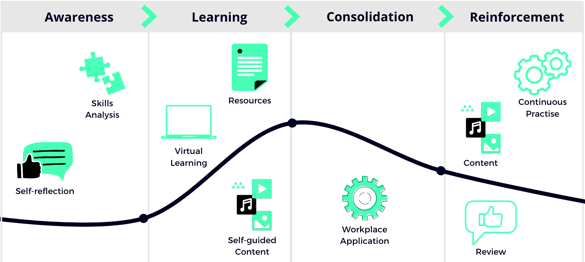The aim of learning and development is, of course, to improve employees’ skills and knowledge to make them more effective and productive within their role. However, as L&D people we are faced with an ongoing problem. Online learning, our primary source of training, isn’t delivering the performance gains needed to justify the cost. The impact of this is huge, with a recent study finding that the monetary loss to a business as a result of ineffective training is as much as $13.5 million per 1000 employees1. Just think how much it’s currently costing your business.
So, what’s causing this problem? Let’s take a look at the current online learning journey and dissect the issues.
The Current Online Learner Journey

The current learner journey looks a little like this: Employees are made aware of gaps in their knowledge and skills through either L&D led gap analysis, or in some cases self-reflection. These gaps are then targeted via online learning. Once a course is completed, employees then move on to consolidating their learning by applying it at work, and knowledge is then reinforced through practice and reflection.
This is a learner journey that we’re all familiar with, but is it effective? The data says no…
A recent Docebo study into learning and development found that within a day, your employees will forget 70%, and within a month, 90% of what they learned2. This is represented in the diagram above, where there is an initial spike in knowledge, but it quickly drops off.
Is this really worth the $450 billion3 which is spent on learning and development each and every year?
Let’s break down the problem:
Engagement
When it comes to learning, you could argue that engagement is nine-tenths of the battle, and if we take a look at the numbers it’s fair to say L&D is currently losing that battle with employees. There are many studies into this, and the numbers don’t make for good reading:
87% of millennials feel that their learning experience is boring 475% of managers are dissatisfied with their L&D programme 5
Let’s face it, online learning is rarely exciting, but when engagement is this low we have to acknowledge that we have a real problem on our hands. If we don’t, we will continue down the vicious cycle of disengaged employees not making the most of training, then being even less likely to engage in future because they didn’t improve their skills or performance.
Effectiveness
The end goal of learning and development is to develop your people to be as effective as possible within their roles. However, when you look at the statistics it’s difficult to argue that is happening in reality. Two of the most reliable metrics when considering the effectiveness of L&D are knowledge retention and application; a problem lies in both. Firstly, with regards to knowledge retention, as Docebo's research highlighted, 90% of knowledge isn't retained, which means that many programmes are only 10% effective at best2. When it comes to application, the statistics don’t get much better, a recent study found that only 12% of employees applied new skills from training into practice.6
When the average company spends between £1500-£2500 per employee7, this is an issue, an issue that can be extremely costly - if you have 1000 employees then the monetary wastage can be, at minimum, well over £1,000,000 - this requires companies to rethink how to make their learning and development as effective as possible, as traditional methods just aren’t delivering, due to a lack of both knowledge retention and application, and it’s costing.
Relevancy
Every employee has individual learning needs based on their role, level and personality. Subsequently, these needs must be present within their own individual learning and development opportunities. Online learning in the form of virtual content and self-guided learning promises us the world when it comes to personalising learning, but the statistics paint a very different picture. A recent study found that just 13% of employees4 feel that their learning experiences are actually relevant.
Relevancy is arguably the most important attribute to have within your learning and development and strategy. If it’s not relevant then your people won’t be engaged and if it’s not engaging it won’t be effective. When building our strategies, we must make sure we fully understand where each employee is in their learning journey and target learning accordingly. It is not enough to base learning on their role and department.
Time
Finally, we come to time. When looking at time, there are two things to consider. Firstly, there is the time it takes to see measurable improvements in performance from training. And secondly, there is the time employees actually have to commit to learning.
As L&D people, we face a huge challenge when it comes to implementing learning programmes. It takes up to 18 months to effectively implement new solutions, so making changes to online learning programmes becomes like trying to change the course of a cruise ship. When we consider employee time, the challenge gets even greater. They know that online learning takes time to deliver results, but time is something they don’t feel they have. In 2021, 61% of employees said they don’t have the time to engage with learning8. The result of this is that employees simply don’t engage with your learning programmes, as they feel their time would be better spent on business-critical tasks.
What’s the solution?
It would be easy at this point to suggest that online learning is dead. But the truth is, it’s not. Online learning will, of course, continue to play a key part in our learning programmes. However, as L&D leaders we need to pivot and provide our people with more holistic learning experiences. Holistic learning that acknowledges the fact that our employees need better behaviours, not more knowledge. Holistic learning experiences that increase engagement and relevancy while reducing the time it takes to see results.
To deliver on this, we must focus on competency frameworks and behaviour change that blends online and real-world learning together to deliver powerful results. By implementing clear and detailed frameworks, we are able to more accurately map the learning needs of every single employee in our organisation. Then we are able to guide employees through our frameworks with behaviour change programmes that are stimulating, compelling and purposeful. This won’t just engage them in purely developing themselves, it will also have a profound impact on their engagement with your company as a whole, due to the implementation of positive and constructive behaviours.
Want to find out more about the power of practice and behaviour change?
Speak to a member of our team today!
1 https://elearningindustry.com/5-facts-about-corporate-training-hard-believe
2 https://www.growthengineering.co.uk/what-is-the-forgetting-curve
3 https://www.globaleducationtimes.org/news/global-ld-market-to-be-worth-446-billion-by-2020
5 https://hbr.org/2016/10/why-leadership-training-fails-and-what-to-do-about-it
6 https://hbr.org/2019/10/where-companies-go-wrong-with-learning-and-development
8 https://gethownow.com/blog/5-reasons-you-should-give-your-team-a-learning-budget/


